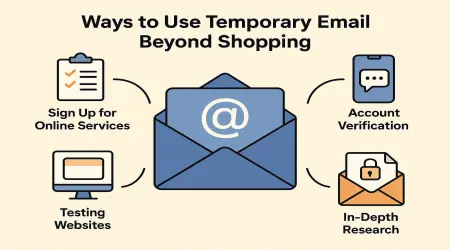

First Line of Defense: Why You Need Temporary Email for Cryptocurrency Registrations
In the electrifying, high-stakes world of cryptocurrency, your digital identity is both your greatest asset and your most significant vulnerability. Every new exchange you test, every airdrop you chase, and every forum you join creates a breadcrumb trail that can lead directly back to you. This exposure is a goldmine for sophisticated hackers and relentless spammers.
But what if you could explore the vast crypto ecosystem without putting your primary identity at risk?
This is where a temporary email becomes one of the most powerful tools in a crypto enthusiast's arsenal. It's not just a smart move; it's a fundamental strategy for layered security. This guide will provide an exhaustive look into using disposable email for cryptocurrency registrations, covering the strategic benefits, the critical risks, and the best practices that separate savvy investors from easy targets. As a leading provider in online privacy, we at temporarymail.info have seen firsthand how crucial this first line of defense can be.

The Hard Data: A Snapshot of Crypto-Related Cybercrime
To understand the sheer scale of the risks involved, let's look at the data. These aren't isolated incidents; they are part of a massive, professionalized ecosystem of cybercrime targeting crypto users. Your personal information, especially your email, is the entry point for many of these attacks.
Here’s a summary of the most recent findings from top cybersecurity and federal investigation reports:
| Threat Vector | Key Statistic (Based on 2024 Data) | Authoritative Source |
|---|---|---|
| Total Illicit Transaction Volume | Estimated to exceed $51 Billion in value received by illicit cryptocurrency addresses. | Chainalysis 2025 Crypto Crime Report |
Reported Crypto Investment Fraud Losses (US) | $9.3 Billion reported to the FBI, a staggering 66% increase from the previous year. | FBI Internet Crime Complaint Center (IC3) 2024 Report |
| Direct Theft from Hacking & Exploits | $2.2 Billion stolen directly from cryptocurrency platforms, with DeFi protocols being the top targets. | CoinLedger 2025 Crypto Crime Report |
| Phishing as an Attack Vector | Cryptocurrency platforms were the target of 2.3% of all global phishing attacks. | Keepnet Labs Phishing Statistics 2025 |
As the data clearly shows, the crypto space is a primary battleground for cybercrime. Your personal email is a direct link to your assets and a key target for attackers aiming to exploit these massive financial opportunities. Protecting it is not optional—it's essential for survival.
Why Privacy is the Most Undervalued Asset in Crypto
Before we dive into the "how," we must first understand the "why." The foundational promise of cryptocurrency was privacy, but the reality is more complex. Most blockchain transactions are pseudonymous, not anonymous. Your wallet address isn't tied to your name, but if your email—linked to your real-world identity—is ever connected to that address, your entire financial privacy can unravel.
- The Doxxing Threat: Doxxing is the malicious act of revealing someone's private information online. If a hacker links your personal email (and through it, your name and social media) to a crypto wallet holding significant assets, you could become a target for extortion, theft, or even physical harm.
- Hyper-Targeted Phishing Attacks: The biggest crypto security threat isn't a brute-force hack; it's a clever phishing email. In 2023, the FBI’s Internet Crime Complaint Center (IC3) received reports of losses totaling over $3.94 billion from cryptocurrency investment scams. When a crypto platform suffers a data breach, user emails are the first thing to leak. Hackers then craft convincing emails like "Urgent: Your Account Has Been Suspended" to steal your credentials. Using a throwaway email for non-essential platforms ensures your primary account isn't in the line of fire.
- Reducing Your Digital Footprint: Every registration adds to your digital footprint. A larger footprint means more potential points of failure. A temporary email address is, by its nature, designed to minimize this footprint, creating dead ends for data harvesters and hackers.
The Strategic Role of Temporary Email in Your Crypto Workflow
A temporary email is a self-destructing, anonymous inbox designed for single-use purposes. Think of it as a digital firewall. You can get a free, instantly-generated address from a service like
The primary function is identity segregation. You are creating a clean break between your real-world identity and your exploratory crypto activities. This allows you to interact with the ecosystem with a layer of insulation.
Smart Use Cases: When to Use a Temporary Email in Crypto
Using a disposable email is about being strategic. It’s the perfect tool for the "top of the funnel"—the initial, low-stakes interactions you have across the crypto landscape.
- Initial Vetting of Crypto Exchanges: Want to check out the user interface of a new exchange before committing? Use a temporary email for the initial sign-up. You can explore the platform, check its features, and see if you like it. Crucial Caveat: If you decide to deposit funds, you must change the account's email to a permanent, secure one and enable 2FA before completing any KYC verification.
- Participating in Airdrops and ICOs: Airdrops are notorious for leading to a deluge of spam and marketing emails. Using a temp mail is the gold standard for participating in these events. You provide an email that can receive the confirmation, and you never have to worry about the subsequent spam flooding your professional inbox.
- Joining Crypto Forums and Communities: Platforms like Bitcointalk or various crypto subreddits are invaluable for research. However, registering with your primary email links your crypto interests directly to your identity. A temporary email allows you to participate in discussions and gather information anonymously.
- Subscribing to Crypto Newsletters: Stay informed without the clutter. Subscribe to market updates, analysis, and news using a disposable address to keep your main inbox clean and focused on high-priority communications.
- Testing New dApps and Web3 Services: The decentralized world is full of exciting but often unaudited applications. When a new dApp asks for an email for notifications, using a temporary one is a wise security measure until the platform has proven its trustworthiness.
Ready to start protecting your digital identity?
The Unbreakable Rules: When to NEVER Use a Temporary Email
This is the most important section of this guide. Using a temporary email in the wrong situation can lead to a total and irreversible loss of your assets.
- Accounts with KYC (Know Your Customer) Verification: KYC regulations require you to submit official identification. This account is now tied to your real-world identity. It must be protected by a secure, permanent email that you control exclusively. Using a temporary email here is pointless and dangerous.
- Your Primary, High-Value Exchange Accounts: Any exchange where you store significant funds (e.g., Binance, Coinbase, Kraken) needs the highest level of security. This means using a dedicated, permanent email with a strong, unique password and robust 2FA.
- Anything Requiring Password Resets: If you forget the password for an account linked to a temporary email, your funds are gone forever. The email address will have self-destructed, and you will have no way to receive the password reset link. This is a non-negotiable rule.
- Receiving Wallet Recovery Information: Private keys, seed phrases, and recovery instructions should never touch a temporary email inbox. These must be stored offline and secured physically.
Advanced Security: The Ultimate Email Strategy for Crypto
A temporary email is your first line of defense, but a complete strategy requires more. To operate safely in the crypto space, you need a tiered email system.
- Tier 1: The Disposable Layer (e.g., temporarymail.info):
- Purpose: Exploration, airdrops, forums, newsletters.
- Security: Anonymous, no personal data attached.
- Outcome: Maximum privacy, zero spam in your main inbox.
- Tier 2: The Secure Permanent Layer (e.g., ProtonMail, Tutanota):
- Purpose: Your main crypto exchange accounts (post-KYC), and high-value services.
- Security: End-to-end encryption, strong 2FA, not linked to your public identity. It is highly recommended to use an
encrypted email provider - Outcome: A secure, private, and recoverable home for your most valuable digital assets.
- Tier 3: Your Personal/Professional Email (e.g., Gmail, Outlook):
- Purpose: Daily life, work, social media.
- Security: Should be kept as far away from your crypto activities as possible.
- Outcome: A clean separation between your public life and your financial activities.
Additional Best Practices:
- Use an Authenticator App for 2FA: Always choose app-based 2FA (like Google Authenticator or Authy) over SMS 2FA. SIM-swapping is a common attack vector used to intercept SMS codes.
- Invest in a Hardware Wallet: The saying goes, "Not your keys, not your crypto." For long-term holding, move your assets off exchanges and onto a
hardware wallet like Ledger or Trezor - Use a Unique Password for Every Single Site: A password manager (like Bitwarden or 1Password) is not optional; it's essential. If one site is breached, the hackers can't use that password to access your other accounts.
Real-World Scenarios: Success Stories and Cautionary Tales
Theory is one thing; real-world experience is another. Here’s how this plays out for actual users.
- The Success Story:
- “I was skeptical about a new DeFi platform but wanted to get in on their promotional airdrop. I used a temp mail from temporarymail.info to register. I received the airdropped tokens in my wallet and promptly forgot about the account. Months later, I learned the platform had a massive data breach. My temp email inbox was full of phishing attempts, but my primary email was completely untouched. It was a simple step that saved me from a major headache.”
- The Cautionary Tale:
- “I signed up for a small, lesser-known crypto exchange using a 10-minute mail because I didn't want the spam. I deposited about $100 of an altcoin to test it out. I got busy and forgot about it. When I returned two months later, the price had skyrocketed, but I couldn't remember my password. The 10-minute mail I used was long gone. The password reset was impossible. I had to watch my investment, now worth thousands, sit there, completely inaccessible. It was a painful lesson.”
The Bottom Line: Use the Right Tool for the Right Job
A temporary email is not a silver bullet, but it is an indispensable tool for privacy and security in the cryptocurrency world. Its power lies in its strategic application. By using it for all your initial, exploratory, and non-critical interactions, you build a powerful buffer that protects your core digital identity from spam, phishing, and doxxing.
Always remember the golden rule: for anything of value or anything that might ever require account recovery, use a dedicated, secure, and permanent email address.
By adopting a layered security approach—combining disposable emails for the perimeter with encrypted emails and hardware wallets for the core—you can navigate the exciting world of crypto with confidence and peace of mind.
Ready to take the first step in securing your crypto journey?
Frequently Asked Questions (People Also Ask)
Q1: Is it truly safe to use a temporary email for cryptocurrency activities?
Yes, it is safe for low-stakes actions such as signing up for newsletters, testing platforms, or joining forums. ❌ But it is not safe for accounts involving stored funds, KYC verification, or password recovery.
Q2: Can I use a temp mail for major exchanges like Binance, Coinbase, or Kraken?
You can use it for exploring the platform only. Before depositing money or submitting KYC documents, you must update to a permanent secure email (like ProtonMail). Using temp mail for a funded account risks losing your assets.
Q3: What is the main difference between a temporary email and a secure email like ProtonMail?
Temporary email (e.g., from temporarymail.info): anonymous, disposable, self-destructing. Best for one-time sign-ups.
Secure email (e.g., ProtonMail): permanent, encrypted, private. Best for long-term and sensitive accounts.
Q4: Will using a temporary email make my crypto transactions anonymous?
No. A temp email only anonymizes the sign-up process. On-chain transactions on Bitcoin or Ethereum remain pseudonymous and traceable. True anonymity requires privacy tools like mixers or privacy coins.
Q5: What should I do if a crypto platform I used a temp mail for gets hacked?
Nothing—this is exactly why temporary emails exist. If hacked, the leaked email is a dead end, unrelated to your real identity or other accounts. Hackers might send phishing emails, but they will target an address that no longer exists.




